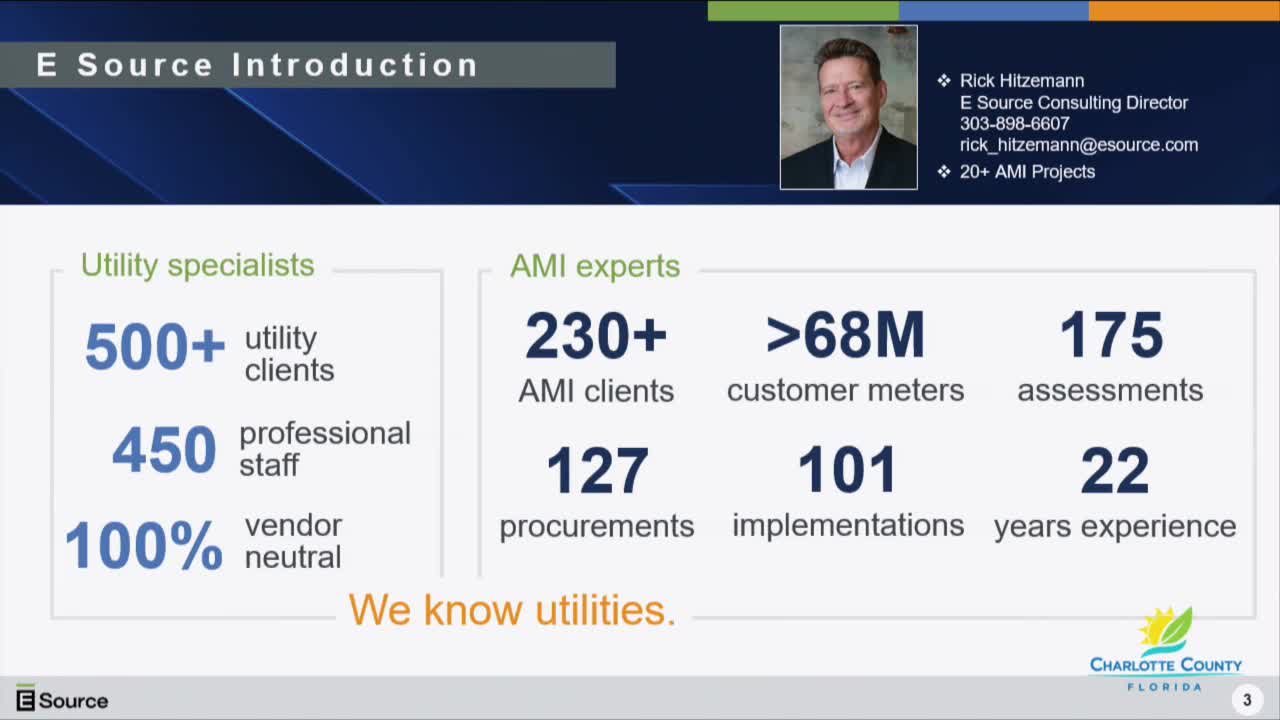County staff reviews AMI problems and recommends pilots; developers and commissioners ask for alternatives
October 14, 2025 | Charlotte County, Florida
This article was created by AI summarizing key points discussed. AI makes mistakes, so for full details and context, please refer to the video of the full meeting. Please report any errors so we can fix them. Report an error »

Charlotte County received an outside AMI (advanced metering infrastructure) assessment Oct. 14 that mapped failures in the county’s radio-frequency automatic meter-reading system and recommended short-term fixes and pilots for alternatives.
Findings: Consultant eSource reported that the county’s AMI network had reported as much as a 15–25% failed-read rate when the study began; industry expectations are typically under 1–1.5% for properly tuned systems. Causes cited in the review included accumulated debris and sand inside meter boxes, prolonged deferred meter maintenance (exacerbated by pandemic-era backlogs), buried or incorrectly mapped conduits and antenna placement problems, and some device/component reliability concerns after storm events.
Short-term actions taken and recommended: County operations have already begun cleaning meter boxes, accelerating meter maintenance and replacing failing registers; the vendor (Mueller) and the county performed some network tuning that substantially reduced failures as of the most recent data. The consultant recommended continuing network tuning, running a formal RF propagation study to identify coverage gaps, and piloting other approaches — notably cellular endpoints and lid/antenna upgrades — before committing to a comprehensive replacement. Staff also proposed a 5‑ to 10‑year metering roadmap and data-management work to ensure meter data becomes reliably available for leak detection and customer portals.
Board questions and requests: Commissioners asked for a short pilot to test cellular meters and for exploration of whether electric-utility meter locations or infrastructure could be used to host communications that would serve water meters. Commissioners asked staff to examine alternative meter brands and a formal pilot program to compare performance, warranty coverage, and life-cycle cost. The board expressed particular interest in preventing the county from repeating earlier large-scale implementation problems and requested clear information on actual replacement/repair warranty coverage and total costs associated with manual reading backlog.
Operational context: Staff reported that meter-cleaning efforts and some network fixes reduced the failed-read percentage in recent months, but warned the county has not yet experienced a major storm since those improvements, so the durability of the fixes under severe weather remains to be proven. Staff also emphasized that cellular options shift expenses from capital (owned network) to operating expense (monthly service) and that any vendor change would require procurement and compatibility checks with existing meter‑data management software.
Ending: Commissioners directed staff to return with a brief, costed pilot plan that includes cellular and other vendor options, with an eye to proving reliability under Charlotte County environmental conditions before considering broader replacement.
Findings: Consultant eSource reported that the county’s AMI network had reported as much as a 15–25% failed-read rate when the study began; industry expectations are typically under 1–1.5% for properly tuned systems. Causes cited in the review included accumulated debris and sand inside meter boxes, prolonged deferred meter maintenance (exacerbated by pandemic-era backlogs), buried or incorrectly mapped conduits and antenna placement problems, and some device/component reliability concerns after storm events.
Short-term actions taken and recommended: County operations have already begun cleaning meter boxes, accelerating meter maintenance and replacing failing registers; the vendor (Mueller) and the county performed some network tuning that substantially reduced failures as of the most recent data. The consultant recommended continuing network tuning, running a formal RF propagation study to identify coverage gaps, and piloting other approaches — notably cellular endpoints and lid/antenna upgrades — before committing to a comprehensive replacement. Staff also proposed a 5‑ to 10‑year metering roadmap and data-management work to ensure meter data becomes reliably available for leak detection and customer portals.
Board questions and requests: Commissioners asked for a short pilot to test cellular meters and for exploration of whether electric-utility meter locations or infrastructure could be used to host communications that would serve water meters. Commissioners asked staff to examine alternative meter brands and a formal pilot program to compare performance, warranty coverage, and life-cycle cost. The board expressed particular interest in preventing the county from repeating earlier large-scale implementation problems and requested clear information on actual replacement/repair warranty coverage and total costs associated with manual reading backlog.
Operational context: Staff reported that meter-cleaning efforts and some network fixes reduced the failed-read percentage in recent months, but warned the county has not yet experienced a major storm since those improvements, so the durability of the fixes under severe weather remains to be proven. Staff also emphasized that cellular options shift expenses from capital (owned network) to operating expense (monthly service) and that any vendor change would require procurement and compatibility checks with existing meter‑data management software.
Ending: Commissioners directed staff to return with a brief, costed pilot plan that includes cellular and other vendor options, with an eye to proving reliability under Charlotte County environmental conditions before considering broader replacement.
View full meeting
This article is based on a recent meeting—watch the full video and explore the complete transcript for deeper insights into the discussion.
View full meeting